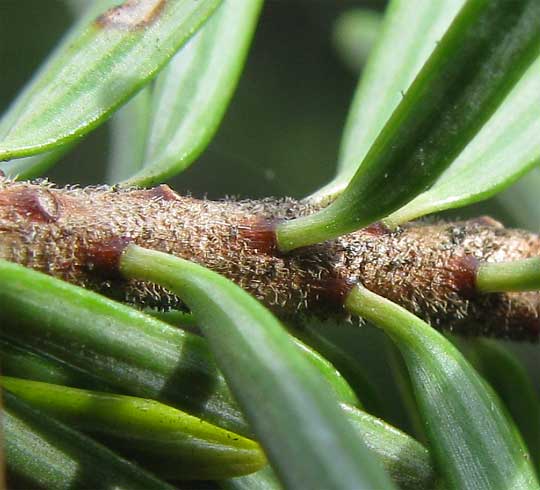Excerpts from Jim Conrad's
Naturalist Newsletter
from the April 19, 2009 Newsletter, issued from the Siskiyou Mountains west of Grants Pass, Oregon:
DOUGLAS-FIRS
No place on Earth has a greater diversity of conifers than here. This week the conifer I've focused on is the Douglas-Fir, PSEUDOTSUGA MENZIESII, which is so common here, growing up to 200 ft (60 m) tall, and such an important timber tree, that it's Oregon's state tree. From a distance Douglas-firs look like so many other tall evergreens with straight, dominant central trucks bearing short branches attached more or less at right angles. Up close, however, you can see how it differs from similar trees. Look at the cone below:

The most conspicuous difference between that three-inch long cone and a pine cone is the three-pointed bracts emerging from beneath each of the cone's woody scales, looking like the rear ends of flattened mice. Other conifers don't have such bracts. Even after the cones fall you can tug on the bracts and they don't come loose. Sometimes you can lift up a bract and a winged seed plops out, like the three seeds at the picture's lower left corner.

The Douglas-Fir's twigs also are distinctive. Above you see a close-up of its short-hairy twig. Notice how the spirally arranged, small-based, flattened leaves arise from slightly raised and tilted little stumps. When you pull leaves off other conifers in this area either what remains is a petiole-scar flush with the surface (firs) or else the stump stands much higher, causing the de-leafed stem to be rough enough to comb your hair with, which I've often done. Spruce and hemlock twigs are like that. Pines and larch also occur here, but they produce clusters of needles instead of individual leaves or needles along their stems.
Notice that the name Douglas-Fir has a hyphen between Douglas and Fir. That's because Douglas-Firs are not firs; they're Douglas-Firs, something completely different. Regular firs belong to the same family, but they're in a different genus, Abies, no Pseudotsuga. Fir cones, instead of dangling like this and other conifer cones are held upright.